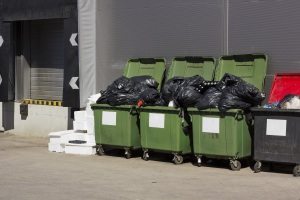
To keep foods and beverages safe, it is important that you manage your waste according to regulations set by FSSAI. These guidelines (Schedule 4) ensure that waste does not come in contact with food, either directly or indirectly, through flies and insects or through more serious contaminants like effluents. Cross contamination from flies and insects that have come in contact with waste and effluents could carry bacteria to the food from the waste.
Disposal of Food Waste (in Food Areas)
- Remove food waste and other waste materials from the areas where the food is being handled cooked or manufactured in a routine manner
- Provide refuse or dustbin of adequate size and with a cover in the premises for collection of waste. A bin should have a mechanism for opening it without having to touch it
- Have the dustbin emptied and washed daily with disinfectant and dried before next use
- Separate liquid and solid waste at the time of placing them in the bins
- Locate your garbage cans in such a manner that it does not lead to contamination of the
- food process
- food storage area
- environment inside and outside your premises
- Keep all waste in covered containers, get it removed at regular intervals as per local law
- Internal garbage bins should be all collected together daily at an assigned collection point where they can be emptied into a public garbage collection system
- Place the bins in a sufficient distance to prevent contamination
- Dispose food waste in such a way that it does not attract dogs, cats, birds, rodents and flies. Garbage cans must have covers
- Follow the rules and regulations including those for plastics and other non environment friendly materials
Storage of Waste and Inedible Material
- Provide enough storage facility for storing of waste and inedible material prior to removable from the premises
- Ensure there is no pest and rodent access to waste of inedible material
- Ensure that stored and inedible material does not contaminate
- potable water
- equipment used for food preparation
- or building/premises
Effluent and Waste Disposal (Especially for Meat Processing Units)
- Have an efficient effluent and waste disposal system in your meat processing unit
- The effluent lines including sewer system must be constructed in such a way that they
- are able to carry large peak loads
- must not contaminate potable water lines
- have a biological oxygen demand of less than 1500
- Install an effluent treatment plant if necessary to dispose of effluents like gases, liquids and solids in conformity with Factory/Environment Pollution Control Board
Based on the comments & suggestions received, Food Safety Helpline would like to suggest the following:
- There should be an arrangement of separation of the biodegradable and non-biodegradable waste before placing in separate bins
- Mark waste trolleys and bins with defining symbols or have different colours for biodegradable and non-biodegradable waste/refuse bins
Eric says
Good and comprehensive information, keep it up
Michael says
Excellent article!! I came across your blog, and there I found most valuable information about Food Safety Guidelines for Waste Storage & Disposal in the Food Units. It’s very informative and helpful.Thanks for sharing.